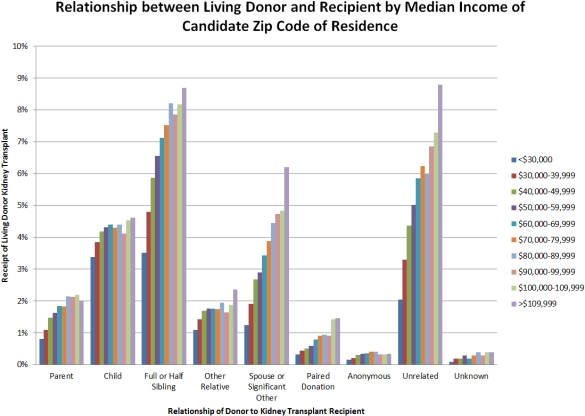Association of Neighborhood Poverty and Living Donor Kidney Transplant Rates by Donor Relationship to Recipient.
Medicine, University of Virginia, Charlottesville, VA.
Meeting: 2016 American Transplant Congress
Abstract number: 130
Keywords: Donation, Kidney transplantation
Session Information
Session Name: Concurrent Session: Kidney Donor Surgery and Outcomes
Session Type: Concurrent Session
Date: Sunday, June 12, 2016
Session Time: 4:30pm-6:00pm
 Presentation Time: 5:30pm-5:42pm
Presentation Time: 5:30pm-5:42pm
Location: Ballroom B
Background: Living donor (LD) kidney transplant is associated with increased access to transplant and improved patient and allograft outcomes. Despite the known benefits, LD rates are declining in the US. We sought to understand the influence of socioeconomic status on donor-recipient relationship status.
Methods: All adult candidates listed for kidney or kidney pancreas transplant listed in the SRTR database from 2000 to 2010 were identified and data linked to US census data on median income by zip code. Candidate zip code of residence was used as a surrogate marker for neighborhood poverty. Univariate and proportional hazards modeling of LD recipients evaluated the independent effects of candidate age, race/ethnicity (Caucasian, AA, Hispanic, Asian, or Other), gender, initial status at listing (active or inactive), ABO, sensitization by PRA, history of prior transplant, primary insurance, educational attainment, etiology of ESRD, dialysis status at listing, first OPO of listing, year of listing, listing for pancreas transplant, and median income of zip code by decile. Sensitivity analyses comparing candidate zip code to other markers of socioeconomic status, including insurance type and education, yielded similar findings.
Results: Increasing candidate neighborhood wealth was associated with increased likelihood of obtaining a LD across all relationship types. Increased neighborhood wealth was most likely to be associated with LD for spouses (OR 5.2), paired donor exchange (OR 5.0), direct unrelated donors (OR 4.4), siblings (OR 2.5), and parents (OR 2.5). Neighborhood poverty had least effect on living donation by children (OR 1.4) and altruistic donors (OR 1.5).

Conclusions: Neighborhood wealth is associated with an increased likelihood of LD for almost all donor-recipient types. Efforts should be made to remove financial disincentives in living donation.
CITATION INFORMATION: Vranic G, Nishio Lucar A, Keith D. Association of Neighborhood Poverty and Living Donor Kidney Transplant Rates by Donor Relationship to Recipient. Am J Transplant. 2016;16 (suppl 3).
To cite this abstract in AMA style:
Vranic G, Lucar ANishio, Keith D. Association of Neighborhood Poverty and Living Donor Kidney Transplant Rates by Donor Relationship to Recipient. [abstract]. Am J Transplant. 2016; 16 (suppl 3). https://atcmeetingabstracts.com/abstract/association-of-neighborhood-poverty-and-living-donor-kidney-transplant-rates-by-donor-relationship-to-recipient/. Accessed December 9, 2025.« Back to 2016 American Transplant Congress
